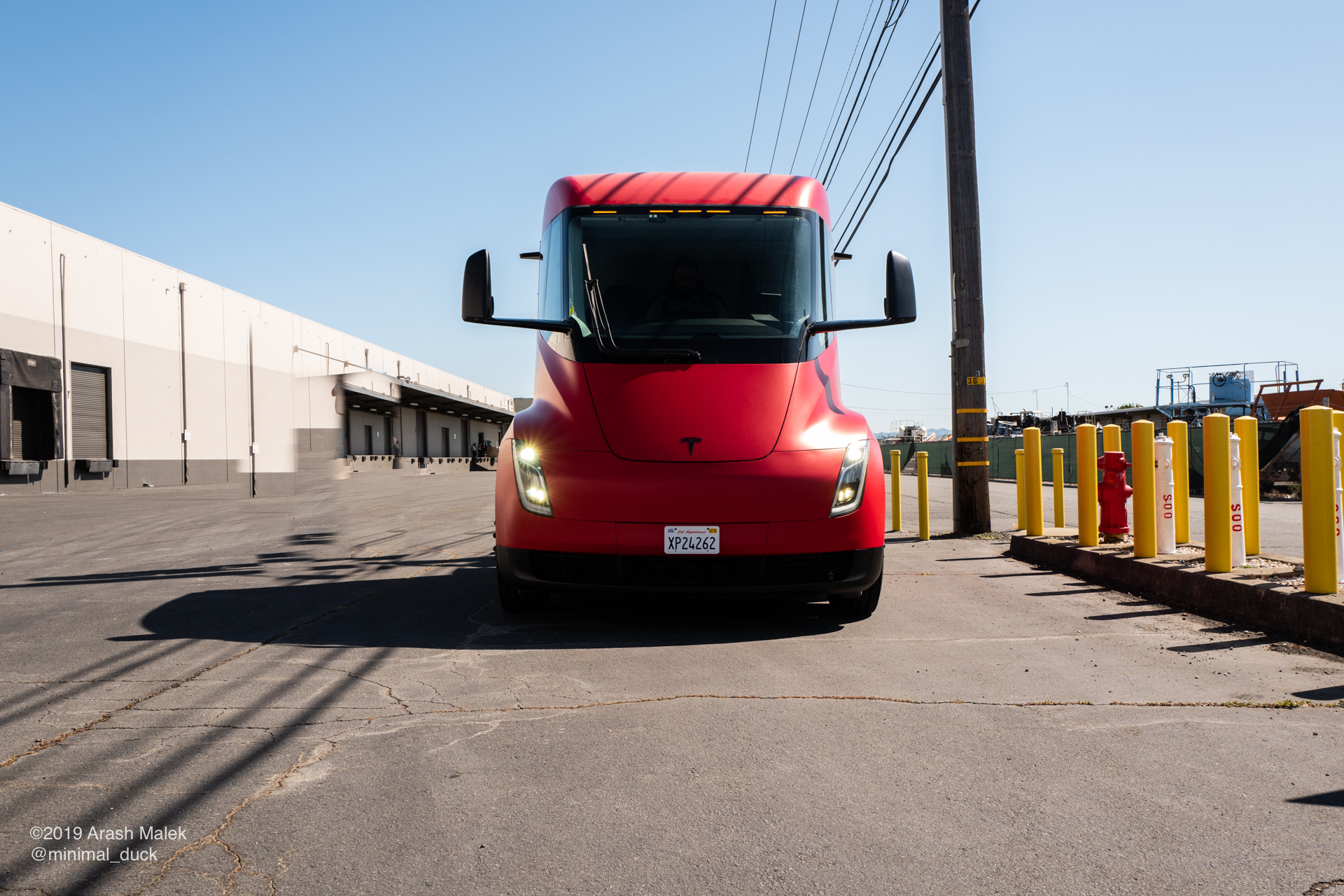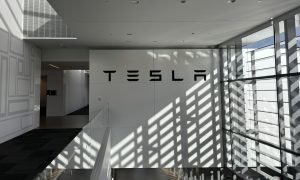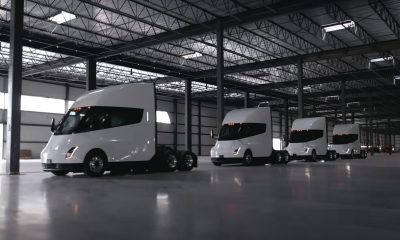

News
Tesla Semi battery weight criticisms are rooted in outdated ideas: EV expert
A good number of skeptics critical of battery-electric long-haulers like the Tesla Semi typically argue that the weight of the vehicles’ batteries makes them ineffective against competitors that are powered by diesel or hydrogen. As noted by an electric vehicle veteran and expert recently, however, these ideas are rooted in outdated ideas about battery weight. And if one considers more recent battery tech, electric Class 8 trucks may not only be feasible; they may actually be closer than expected.
In a recent piece on Bulk Distributor Magazine’s November/December 2020 issue, Auke Hoekstra, Senior Advisor for Electric Mobility at the Eindhoven University of Technology, noted that contrary to popular belief, long-haul trucks would not be the last vehicles to become battery-powered. This is in no small part due to the advancement of battery technology. Hoekstra noted that within five years, he believes that “electric trucks will become the logical choice for many bulk transporters” And within 10 years, vehicles like the Tesla Sei will likely dominate new sales.
The stunning progression of battery technology could be seen in just how much batteries have gotten better and cheaper over the years. Hoekstra noted that myths about electric trucks being too heavy were true 20 years ago, but not today. If electric long-haulers existed 20 years ago, they would likely be powered by lead-acid batteries, and assuming a battery size of 1 MWh, such a vehicle will require a pack that will likely weigh about 25 tons. That’s more than the entire payload of the truck. This is, of course, not the case today.
Hoekstra noted that when he wrote his first book about electric vehicles for the Dutch Ministry of Road Transport 13 years ago, lithium-ion batteries had started to emerge. Lithium-ion batteries offered reductions in weight, resulting in a 1 MWh pack weighing only about 10 tons. Today, this is even better, with modern electric cars having batteries that weigh about 5 kg per kWh or 5 tons per MWh. “I expect that with five years, that weight will be down to 3.5 tons. And it doesn’t stop there,” the EV veteran wrote.
Class 8 trucks like the Tesla Semi, which are designed from the ground up to be electric, will likely offer even better weight advantages. Hoekstra estimated that Tesla would see further weight reductions of about 2.5 to 3 tons due to the vehicle’s all-electric platform. “The electric motor is lighter, and you can get rid of the diesel tank and exhaust treatment. Then you place the electric motors between the wheels and lose the differential, driveshaft, and a host of other components,” he wrote.
What’s particularly interesting is that these estimates don’t even take into account the innovations that Tesla unveiled in its Battery Day event. Once Tesla’s 4680 tabless cells and structural battery packs enter the equation, the Semi becomes an even more compelling alternative to diesel-powered trucks. Hoekstra estimated that Tesla’s structural battery packs could save another ton to the Semi’s overall weight, seeing as the battery would practically displace the steel beams that give traditional Class 8 long-haulers their rigidity. With this in mind, the EV veteran noted that “battery weight will soon be a problem of the past.”
There are other advantages to electric trucks that were highlighted by Hoekstra in his piece, such as the cost savings that will result from the use of a fleet of electric trucks. This is something that Tesla has highlighted in the past, with CEO Elon Musk stating during the vehicle’s unveiling that the Semi will vastly undercut diesel-powered rivals when it comes to operating costs. Couple this with the low maintenance requirements of EVs, as well as the fact that batteries now last much longer, and trucks like the Tesla Semi will likely become very attractive options for operators in the very near future.
News
Tesla begins Robotaxi certification push in Arizona: report
Tesla seems serious about expanding its Robotaxi service to several states in the coming months.

Tesla has initiated discussions with Arizona transportation regulators to certify its driverless Robotaxi service in the state, as per a recent report from Bloomberg News. The move follows Tesla’s launch of its Robotaxi pilot program in Austin, Texas, as well as CEO Elon Musk’s recent comments about the service’s expansion in the Bay Area.
The Arizona Department of Transportation confirmed to Bloomberg that Tesla has reached out to begin the certification process for autonomous ride-sharing operations in the state. While details remain limited, the outreach suggests that Tesla is serious about expanding its driverless Robotaxi service to several territories in the coming months.
The Arizona development comes as Tesla prepares to expand its service area in Austin this weekend, as per CEO Elon Musk in a post on X. Musk also stated that Tesla is targeting the San Francisco Bay Area as its next major market, with a potential launch “in a month or two,” pending regulatory approvals.
Tesla first launched its autonomous ride-hailing program on June 22 in Austin with a small fleet of Model Y vehicles, accompanied by a Tesla employee in the passenger seat to monitor safety. While still classified as a test, Musk has said the program will expand to about 1,000 vehicles in the coming months. Tesla will later upgrade its Robotaxi fleet with the Cyercab, a two-seater that is designed without a steering wheel.
Sightings of Cybercab castings around the Giga Texas complex suggests that Tesla may be ramping the initial trial production of the self-driving two-seater. Tesla, for its part, has noted in the past that volume production of the Cybercab is expected to start sometime next year.
In California, Tesla has already applied for a transportation charter-party carrier permit from the state’s Public Utilities Commission. The company is reportedly taking a phased approach to operating in California, with the Robotaxi service starting with pre-arranged rides for employees in vehicles with safety drivers.
News
Tesla sets November 6 date for 2025 Annual Shareholder Meeting
The automaker announced the date on Thursday in a Form 8-K.

Tesla has scheduled its 2025 annual shareholder meeting for November 6, addressing investor concerns that the company was nearing a legal deadline to hold the event.
The automaker announced the date on Thursday in a Form 8-K submitted to the United States Securities and Exchange Commission (SEC). The company also listed a new proposal submission deadline of July 31 for items to be included in the proxy statement.
Tesla’s announcement followed calls from a group of 27 shareholders, including the leaders of large public pension funds, which urged Tesla’s board to formally set the meeting date, as noted in a report from The Wall Street Journal.
The group noted that under Texas law, where Tesla is now incorporated, companies must hold annual meetings within 13 months of the last one if requested by shareholders. Tesla’s previous annual shareholder meeting was held on June 13, 2024, which placed the July 13 deadline in focus.
Tesla originally stated in its 2024 annual report that it would file its proxy statement by the end of April. However, an amended filing on April 30 indicated that the Board of Directors had not yet finalized a meeting date, at least at the time.
The April filing also confirmed that Tesla’s board had formed a special committee to evaluate certain matters related to CEO Elon Musk’s compensation plan. Musk’s CEO performance award remains at the center of a lengthy legal dispute in Delaware, Tesla’s former state of incorporation.
Due to the aftermath of Musk’s legal dispute about his compensation plan in Delaware, he has not been paid for his work at Tesla for several years. Musk, for his part, has noted that he is more concerned about his voting stake in Tesla than his actual salary.
At last year’s annual meeting, TSLA shareholders voted to reapprove Elon Musk’s compensation plan and ratified Tesla’s decision to relocate its legal domicile from Delaware to Texas.
Elon Musk
Grok coming to Tesla vehicles next week “at the latest:” Elon Musk
Grok’s rollout to Tesla vehicles is expected to begin next week at the latest.

Elon Musk announced on Thursday that Grok, the large language model developed by his startup xAI, will soon be available in Tesla vehicles. Grok’s rollout to Tesla vehicles is expected to begin next week at the latest, further deepening the ties between the two Elon Musk-led companies.
Tesla–xAI synergy
Musk confirmed the news on X shortly after livestreaming the release of Grok 4, xAI’s latest large language model. “Grok is coming to Tesla vehicles very soon. Next week at the latest,” Musk wrote in a post on social media platform X.
During the livestream, Musk and several members of the xAI team highlighted several upgrades to Grok 4’s voice capabilities and performance metrics, positioning the LLM as competitive with top-tier models from OpenAI and Google.
The in-vehicle integration of Grok marks a new chapter in Tesla’s AI development. While Tesla has long relied on in-house systems for autonomous driving and energy optimization, Grok’s integration would introduce conversational AI directly into its vehicles’ user experience. This integration could potentially improve customer interaction inside Tesla vehicles.
xAI and Tesla’s collaborative footprint
Grok’s upcoming rollout to Tesla vehicles adds to a growing business relationship between Tesla and xAI. Earlier this year, Tesla disclosed that it generated $198.3 million in revenue from commercial, consulting, and support agreements with xAI, as noted in a report from Bloomberg News. A large portion of that amount, however, came from the sale of Megapack energy storage systems to the artificial intelligence startup.
In July 2023, Musk polled X users about whether Tesla should invest $5 billion in xAI. While no formal investment has been made so far, 68% of poll participants voted yes, and Musk has since stated that the idea would be discussed with Tesla’s board.
-

 Elon Musk1 week ago
Elon Musk1 week agoTesla investors will be shocked by Jim Cramer’s latest assessment
-

 Elon Musk3 days ago
Elon Musk3 days agoElon Musk confirms Grok 4 launch on July 9 with livestream event
-

 Elon Musk14 hours ago
Elon Musk14 hours agoxAI launches Grok 4 with new $300/month SuperGrok Heavy subscription
-

 News7 days ago
News7 days agoTesla Model 3 ranks as the safest new car in Europe for 2025, per Euro NCAP tests
-

 Elon Musk2 weeks ago
Elon Musk2 weeks agoA Tesla just delivered itself to a customer autonomously, Elon Musk confirms
-

 Elon Musk1 week ago
Elon Musk1 week agoxAI’s Memphis data center receives air permit despite community criticism
-

 Elon Musk2 weeks ago
Elon Musk2 weeks agoTesla’s Omead Afshar, known as Elon Musk’s right-hand man, leaves company: reports
-

 News2 weeks ago
News2 weeks agoXiaomi CEO congratulates Tesla on first FSD delivery: “We have to continue learning!”
















